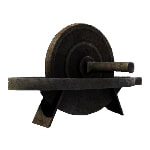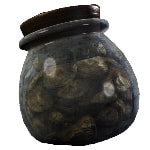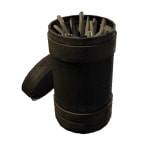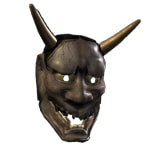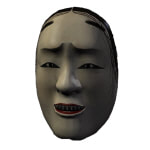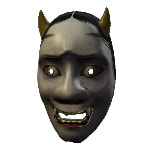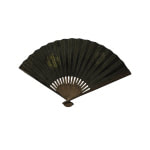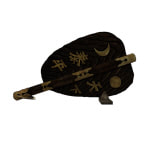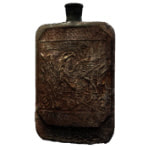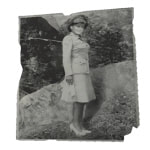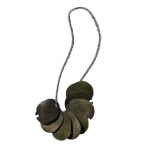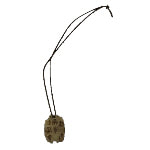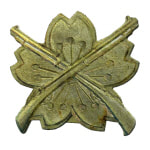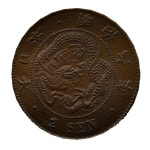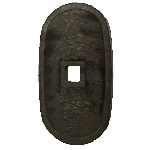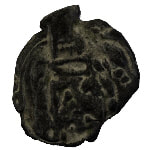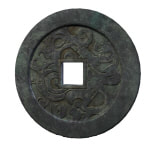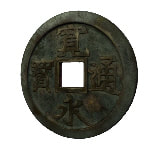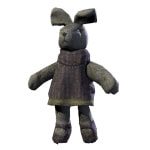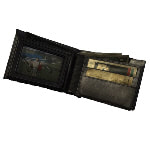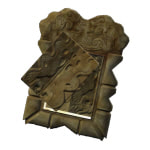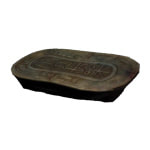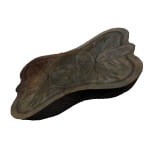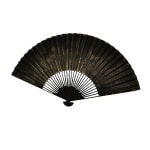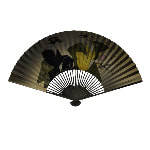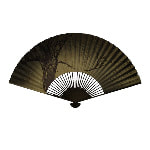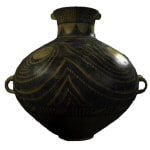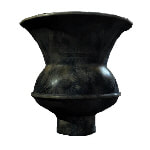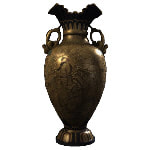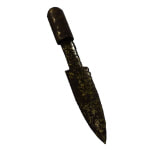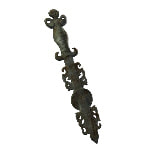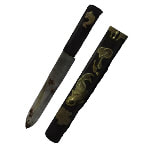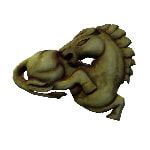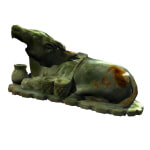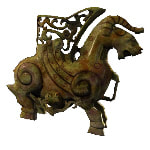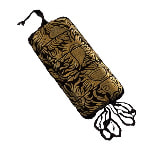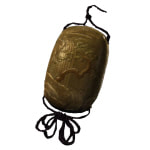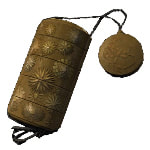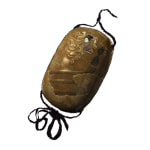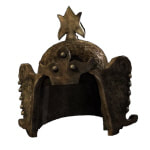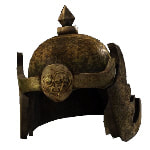Relics
Contents: Kanpo Herbs | Noh Masks | Edo Period Fans | Semper Fi | Senshi Elite | Ancient Coins | Bronze Coins | A Family Outing | Yuan Dynasty Jade | Ceremonial Fans | Vases | Daggers | Animal Statuary | Inro | Helmets
Kanpo Herbs
|
Yagan
A kind of mortar and pestle. Probably used for preparing medicinal herbs. There are small bone fragments in the mortar well. Hopefully animal bones... |
Medicinal Herb Vial
Used in traditional Japanese herbal medicine, or kanpo. It looks like this vial has been sealed for many years. These are probably Maitake mushrooms, used to boost the immune system. |
Dried Gobo Root
It’s Burdock. A root traditionally used in kanpo to fight inflammation. |
Noh Masks
|
Hannya Mask
This traditional noh mask represents a hateful woman in the guise of a demon. There are traces of white paint on the inside. Whoever used this mask was a noble birth. |
Female Noh Mask
Japanese Noh actors could tilt their heads up and down to make the rigid mask express different emotions. |
Oni Noh Mask
This mask was used in the traditional Japanese Noh theatre. I think it represents a demon, or oni. There’s a price tag? Looks like this one is a replica. |
Edo Period Fans
Semper Fi
|
Silver Flask
This must have belonged to a US Marine. Were they on the island in force, or just an advance party? Do these marks represent friends lost or enemies killed? Either way, he needed a drink. |
Old Photograph
Someone looked at this picture many times. It’s been folded and unfolded repeatedly. He never returned home. This island has taken so many lives. |
USMC Dog Tags
American soldiers would never have left these behind. I don’t think any of them made it out of here alive. |
Senshi Elite
Ancient Coins
|
Japanese 2 Sen Coin
The date reads Meiji 6, which is 1873! One side is worn down, as if rubbed repeatedly. Maybe this was a soldier’s good luck coin? |
100 Mon Coin
This is a Tempo Tsuho. Hard to read the date, but Japan made thousands of these in the mid-1800s. |
Portuguese Tin Coin
The Portuguese minted these in the 16th century for their colony in Malacca, which is Malaysia today. This must have come from one of the old galleon wrecks on the island. |
Bronze Coins
Family Outing
|
Stuffed Bunny
Singed around the edges... What happened to your owner? There’s a name on the tag... Millie. |
Toy Train
Where have all the children gone? Another name, carved faintly into the wood. Coco. |
Worn Wallet
There’s a picture of two girls. This wallet belonged to a father... The names on the picture... Millie and Coco. I found their toys. What happened to this poor family? |
Yuan Dynasty Jade
|
Brown Jade Ink Box
This was used by scribes of the Chinese royal court. A small engraving indicates that this was the possession of an Imperial ambassador. |
Stained Jade Headrest
Was this actually used as a head rest, or was it part of a larger statuary set? I’ll research it if I ever get out of this place. |
Shaped Jade Headrest
This one seems shaped to be slightly more comfortable. |
Ceremonial Fans
|
Funeral Fan
Looks to be early 18th century. Black silk fans were used when conducting funeral rites for important nobles. |
Wedding Fan
A fan made for a special occasion, probably a wedding. Doesn’t look older than a few years. |
Inscribed Silk Fan
19th century folded fans were often inscribed with poems or accounts of important events. |
Vases
|
Kansu Burial Urn
This Chinese earthenware is thousands of years old. Could they have visited this island before the rise of Yamatai? |
Ban Chiang Vase
I’ve seen similar artifacts from the Ban Chiang site in Thailand. How did this get all the way to Yamatai? |
Satsuma Vase
A Satsuma porcelain vase, probably early Edo period. |
Daggers
|
Chou Dynasty Dagger
This Chinese dagger is extremely old. My father had a similar one in his collection dating from 854 B.C. |
Jade Ceremonial Dagger
An ancient Chinese dagger, probably around 100AD. How long have ships been crashing on this island? |
Japanese Ceremonial Dagger
This is fairly modern, perhaps 18th century. The gold carp carving was designed to contrast with the black lacquer finish. Blood stains. Someone used this knife recently. |
Animal Statuary
|
Jade Horse
This might be Yuan Dynasty. Could it be from Kublai Khan’s lost fleet? Oh wait, it’s a fake. “Made in China”. |
Jade Water Buffalo
A Ming Dynasty jade figurine, but this one looks genuine. |
Jade Drinking Vessel
It’s a ceremonial drinking vessel from the Song Dynasty. Beautiful craftsmanship! |
Inro
|
Decorative Inro
In Edo Japan, traditional men’s garments had no pockets. Inro were miniature containers used to hold personal effects, like an ancient form of wallet. Scribe’s Inro
This gold lacquered inro contains writing implements and dried ink. Likely the possession of a court scribe or historian. |
Metal Inro
Inro are usually lacquered wood, but this one’s made of brass. Probably dates from the 19th century. The inside of this inro smells like tobacco. Perhaps this was used as an ancient cigarette case... |
Commander’s Inro
This inro was probably used by a military commander to carry official orders and seals. |


